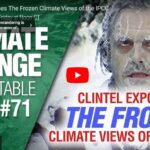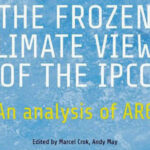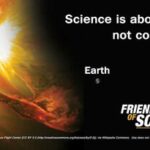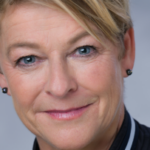Voor het vierde nummer van de vierde jaargang van de Atmospheric Sciences Section van de Newsletter van de American Geophysical Union heeft de twijfelende IPCC-adept Hans von Storch de openlijke IPCC-kritikaster Roger Pielke Sr. geïnterviewd. Het interview was de laatste in een serie van 6 interviews met eminente meteorologen en klimatologen.
Download een pdf met alle 6 interviews via deze link. De interviews hebben deels dezelfde kritische vragen met betrekking tot de politisering van de klimaatwetenschap. Het is opvallend dat geen van de geïnterviewden het voor 100% opneemt voor het IPCC. Roger Pielke Sr. die bekend staat als een “honest broker” (term verzonnen door zijn zoon Roger Pielke Jr.) komt met een interessant alternatief proces voor het nu verzandende IPCC.
Prof Pielke, you are an atmospheric scientist what were the main scientific issues you have tackled in your long professional career?
Our research team has investigated a wide range of climate processes. This includes studies in meteorology, hydrology, ecology and oceanography. Among our findings has been the clear demonstration of the close coupling between land surface processes and weather. I have also worked extensively to improve our understanding of the transport and dispersion of air pollution, as well as ways to reduce the risk from this environmental hazard.
Lees hieronder de rest van het interview…
How do you weigh the role and the potentials of models?
Models are powerful tools with which to understand how the climate system works on multidecadal time scale as long as there are observations to compare reality with the model simulations. However, when they are used for predictions of environmental and societal impacts decades from now in which there is no data to validate them, such as the IPCC predictions decades into the future, they present a level of forecast skill to policymakers that does not exist. These predictions are, in reality model sensitivity studies and as such this major limitation in their use as predictions needs to be emphasized. Unless accompanied by an adequate recognition of this large uncertainty they imply a confidence in the skill of the results that does is not present.
You have become known for dissenting views in the present debate about the perspective of anthropogenic climate change. For example, you stress the role of land uses chances as another key driver in influencing our climate. Could you outline your position?
My perspective is summarized in a recent publication with 18 other Fellows of the American Geophysical Union in an EOS article titled “Climate change: The need to consider human forcings besides greenhouse gases” [Pielke Sr. et al., 2009]. We wrote “the 2007 Intergovernmental Panel on Climate Change (IPCC) assessment did not sufficiently acknowledge the importance of these other human climate forcings in altering regional and global climate and their effects on predictability at the regional scale” and because “global climate models do not accurately simulate (or even include) several of these other first order human climate forcings, policymakers must be made aware of the inability of the current generation of models to accurately forecast regional climate risks to resources on multidecadal time scales.”
If you were right, how would the range of options for response measures for limiting manmade climate change within certain bounds differ from what is commonly considered?
We need to recognize that the IPCC starts from an inappropriately narrow perspective that the human input greenhouse gases is the dominate environmental concern in the coming decades and then the IPCC presents policymakers with a resulting broad range of expected regional and local impacts. This is, however, at best a flawed significantly, incomplete approach. The IPCC process should be inverted. In our 2009 EOS article that I referred to above, we recommend that the next assessment phase of the IPCC (and other such assessments) broaden its perspective to include all of the human climate forcings. It should also adopt a complementary and precautionary resource based assessment of the vulnerability of critical resources (those affecting water, food, energy, and human and ecosystem health) to environmental variability and change of all types. This should include, but not be limited to, the effects due to all of the natural and human caused climate variations and changes. After these threats are identified for each resource, then the relative risk from naturaland humancaused climate change (estimated from the GCM projections, but also the historical, paleorecord, and worst case sequences of events) can be compared with other environmental and social risks in order to adopt the optimal mitigation/adaptation strategy.
The issues we should focus on can be summarized in this set of questions:
- Why is this resource important? How is it used? To what stakeholders is it valuable?
- What are the key environmental and social variables that influence this resource?
- What is the sensitivity of this resource to changes in each of these key variables? (this includes, but is not limited to, the sensitivity of the resource to climate variations and change on short (e.g. days); medium (e.g. seasons) and long (e.g. multidecadal) time scales.
- What changes (thresholds) in these key variables would have to occur to result in a negative (or positive) response to this resource?
- What are the best estimates of the probabilities for these changes to occur? What tools are available to quantify the effect of these changes. Can these estimates be skillfully predicted?
- What actions (adaptation/mitigation) can be undertaken in order to minimize or eliminate the negative consequences of these changes (or to optimize a positive response)?
- What are specific recommendations for policymakers and other stakeholders?
I have been commissioned as Chief Editor of a set of five books which will apply this bottomup, resource based perspective.
You have retired a few years ago from your active duty as a professor at Colorado State University. Did retirement present for you a loss of opportunities, for instance with respect to teaching, or an opening of new possibilities?
I continue to work with graduate students at the University of Colorado, and at other institutions including Purdue University and the University of Alabama at Huntsville. I continue to be active in research and mentoring of younger scientists.
What would you consider the most two significant achievements in your career?
First, the opportunity to mentor graduate students and postdoctoral research staff, a number of who have become leaders in atmospheric and climate science has been an achievement I am proud of. Second, the perspective that climate is an integrated nonlinear physical, chemical and biological system, which requires the understanding of all components of the atmosphere, ocean, land and cryosphere, is starting to become more widely accepted. I have sought to promote this view over the last 20 year. This broader view of climate as a complex, nonlinear geophysical system is more scientifically robust than has been presented in the IPCC reports.
When you look back in time, what where the most significant, exciting or surprising developments in atmospheric science?
The ability to monitor the climate system from space has provided a much better understanding of climate as a system. We also are developing an improved recognition of the difficult challenges we face in seeking to skillfully predict climate decades from now. In terms of negative developments, the bias in the funding of climate science research which tends to exclude perspectives that differ from the IPCC viewpoint is a major concern. Also, the introduction in the last 1015 years of the publication in peer reviewed research papers of climate forecasts and impacts decades into the futures. Their publication subverts the scientific process since these predictions are not testable until after that time period has elapsed.
Is there a politicization of atmospheric science?
Very definitely. There is a clear intent, for example, in the climate assessment report process to exclude scientists who disagree with the IPCC perspective from research papers and from funding. This was exemplified in the CRU emails, but it is a much wider problem as I have documented on my weblog, testimony to the U.S. Congress and in Public Comments.
What constitutes “good” science?
“Good” science is completed when hypotheses are presented and tested with real world data to see if they can be refuted. Unfortunately, the IPCC uses multidecadal global climate model predictions as a basis for policy action yet these model predictions cannot be tested since we need to wait decades to obtain the real world data. Even in hindcasts of the last few decades, these models have shown no regional predictive skill.
What is the subjective element in scientific practice? Does culture matter? What is the role of instinct?
Science needs to advance by following the scientific method. This needs to be independent of culture or any other external influence.
Bio
Roger A. Pielke Sr. is currently a Senior Research Scientist at the Cooperative Institute for Research in Environmental Sciences (CIRES) at the University of Colorado and a Professor Emeritus of the Department of Atmospheric Science, Colorado State University. Pielke has studied weather and climate on local, regional and global scales using both models and observations throughout an over 40 year career. He has authored, coauthored and coedited several books including “Mesoscale Meteorological Modeling” (1984; 2002), “The Hurricane” (1990), ‘Human Impacts on Weather and Climate” (1995; 2006), “Hurricanes: Their Nature and Impacts” (1997) and “Storms” (1999). Roger Pielke Sr. was elected a Fellow of the AMS in 1982 and a Fellow of the American Geophysical Union in 2004. He has served as Chief Editor of the Monthly Weather Review and CoChief Editor of the Journal of the Atmospheric Sciences. He is currently serving on the AGU Focus Group on Natural Hazards (August 2009present) and the AMS Committee on Planned and Inadvertent Weather Modification (October 2009present).
Dr. Pielke has also published over 350 papers in peerreviewed journals, 50 chapters in books, and made over 700 presentations during his career to date. A listing of papers can be viewed at the project website: http://cires.colorado.edu/science/groups/pi elke/pubs/. He is among one of three faculty and one of four members listed by ISI HighlyCited in Geosciences at Colorado State University and the University of Colorado at Boulder, respectively.







Sorry Hajo, maar Roger Pielke Sr. bestempelen als "AGW-skepticus" is onjuist. Hij heeft zich nooit gedistancieerd van AGW. Hij staat hij wel zeer kritisch tegenover de "beperkte" IPCC visie die ervan uit gaat dat CO2 en/of broeikasgassen dominant zijn. RP Sr. ziet de menselijk invloed als veel diverser, iets wat naar zijn mening te weinig onderkent wordt en daardoor tot problemen kan leiden.
Beter zou zijn hem als "openlijk IPCC kritikaster" te bestempelen.
Zie ook alhier:
http://pielkeclimatesci.wordpress.com/2010/09/06/…
HB
OK. Thx. Aangepast. Iemand die zich distantieert van alarmisme is nog geen AGW-"denier". Zou je hem wel een "lukewarmer" kunnen noemen: geringe niet zorgwekkende invloed van CO2 op temperatuurprofiel atmosfeer? Dat is nl. ook mijn positie.
Nee. Zie het door Pielke geciteerde paper in EOS. CO2 enerzijds en landgebruik/hydrologie/etc anderzijds zijn allemaal significant.
Ik citeer, uit de EOS:
"Although the natural causes of climate variations and changes are undoubtedly important, the human influences are signifi cant and involve a diverse range of first- order climate forcings, including, but not limited to, the human input of carbon dioxide (CO2). Most, if not all, of these human influences on regional and global climate will continue to be of concern during the coming decades."
"In addition to greenhouse gas emissions, other first-order human climate forcings are important to understanding the future behavior of Earth’s climate. These forcings are spatially heterogeneous and include the effect of aerosols on clouds and associated precipitation, the influence of aerosol deposition (e.g., black carbon (soot) and reactive nitrogen, and the role of changes in land use/land cover."
(referenties hieruit weggelaten)
Oftewel: Volgens Pielke Sr is antropogeen CO2 wel degelijk een first-order control op het klimaat.
Niks 'lukewarm' dus.
Het is niet zo verbazend dat we ons tot nu toe vooral gefocust hebben op CO2 en "global warming". Deze is namelijk veel eenvoudiger te begrijpen dan regional climate change. Op regionale schaal is veel meer variabiliteit en zijn er veel meer forceringen belangrijk dan op wereldschaal.
@boog
Waar zie jij in deze zin het woord 'co2' staan?
"In addition to greenhouse gas emissions, other first-order human climate forcings are important to understanding the future behavior of Earth’s climate."
Selectief blind, T2000? Ik citeerde
"the human influences are significant and involve a diverse range of first-order climate forcings, including, but not limited to, the human input of carbon dioxide (CO2)."
en, overigens elders in het paper,
"The evidence predominantly suggests that humans are significantly altering the global environment, and thus climate, in a variety of diverse ways beyond the effects of human emissions of greenhouse gases, including CO2."
De kritiek van Pielke cs. richt zich enkel en alleen op het niet afdoende meenemen van de andere factoren náást antropogene broeikasgassen/CO2. Bovenstaande paragraaf vervolgt:
"Unfortunately, the 2007 Intergovernmental Panel on Climate Change (IPCC) assessment did not sufficiently acknowledge the importance of these other human climate forcings in altering regional and global climate and their effects on predictability at the regional scale."
@boog
Fijn dat je mij beticht van selectieve blindheid, maar volgens mij ben je zelf degene die het volgende buiten beschouwing laat:
"and because “global climate models do not accurately simulate (or even include) several of these other first order human climate forcings, policymakers must be made aware of the inability of the current generation of models to accurately forecast regional climate risks to resources on multidecadal time scales.”
En even verderop:
"Good” science is completed when hypotheses are presented and tested with real world data to see if they can be refuted. Unfortunately, the IPCC uses multidecadal global climate model predictions as a basis for policy action yet these model predictions cannot be tested since we need to wait decades to obtain the real world data. Even in hindcasts of the last few decades, these models have shown no regional predictive skill."
Samengevat dat Pielke Sr. 'first order human climate forcing' een grote rol toedicht in het klimaat, waar CO2 er een van is.
Hoe groot de rol van CO2 is laat hij dus wijselijk buiten beschouwing.
Niet vast te stellen dus of hij een 'lukewarmer' is.
Zie ook http://pielkeclimatesci.wordpress.com/2010/05/04/…
waar Pielke in gaat op de 'most of the warming is due to GHG' conclusie van het IPCC. Zijn conclusie:
The 2010 answer to the question by Andy Revkin “Is most of the observed warming over the last 50 years likely to have been due to the increase in greenhouse gas concentrations”?
remains NO.
En na het "NO" vervolgt hij
"The added greenhouse gases from human activity clearly have a role in increasing the heat content of the climate system from what it otherwise would be. However, there are other equally or even more important significant human climate forcings, as I summarized in my 2005 post and in the 2009 article"
Waar het mij om gaat is dat hier de rol van GHG-klimaat bepaalt niet als 'minor' wordt gezien. Misschien niet de allesbepalemde factor nee, maar wél een van de eerste orde factoren.
Dit in tegenstelling tot Hajo's interpretatie
"Zou je hem [Pielke sr] wel een “lukewarmer” kunnen noemen: geringe niet zorgwekkende invloed van CO2 op temperatuurprofiel atmosfeer?"
Waarin GHG wél een 'minor' rol krijgt toebedeeld.
Nogmaals: ik zie geen enkele aanwijzing dat Pielke sr het ook zo ziet.
@boog
Waar lees jij dan dat de rol van GHG niet bepaald 'minor' is?
“The added greenhouse gases from human activity clearly have a role in increasing the heat content of the climate system from what it otherwise would be. However, there are other equally or even more important significant human climate forcings, as I summarized in my 2005 post and in the 2009 article”
De beste man schrijft dat er andere, gelijkwaardige, zels belangrijkere menselijke forcings zijn. Hij decimeert de rol van GHG.
"there are other equally or even more important significant human climate forcings" != "Hij decimeert de rol van GHG"
Okay, dan houd ik jouw redenering aan.
Pielke Sr. schrijft dat er andere, gelijkwaardige zo niet belangrijkere Human Climate Forcings zijn dan GHG.
Volgens jou dat hij de rol van GHG gelijk stelt aan de bevindingen van het IPCC. Dat Is een sensitiviteit van 1,5 tot 6 graden (?).
Dus schat Pielke Sr. in dat deze sensitiviteit meer dan verdubbeld moet worden (gelijkwaardig, zo niet belangrijker).
Je hebt gelijk; hij is de grootste alarmist ter wereld.
"Volgens jou dat hij de rol van GHG gelijk stelt aan de bevindingen van het IPCC. Dat Is een sensitiviteit van 1,5 tot 6 graden"
Je moet me geen woorden in de mond leggen, T2000. Ik heb niets van deze strekking beweerd.
Het enige wat ik heb gedaan is aantonen dat hajo's interpretatie van Pielke zijn uitspraken incorrect zijn.
Boog,
Ik schrijf dat je niet kan vaststellen of Pielke Sr. een "lukewarmer"is.
Ik heb net deze link gelezen waarbij Pielke de oudere ook reageert en na het lezen van vooral reaguurder Albatross is mijn achting in Pielke de oudere niet bepaald meer gestegen. Lukewarmer, skepticus of hoe dan ook, ik moet vooral denken aan een zinsnede uit een song van Arcade Fire: "They will eat right of your hand using big words they don't understand they're are singing rococo rococo rococo". Kortom: don't beat about the bush Roger!